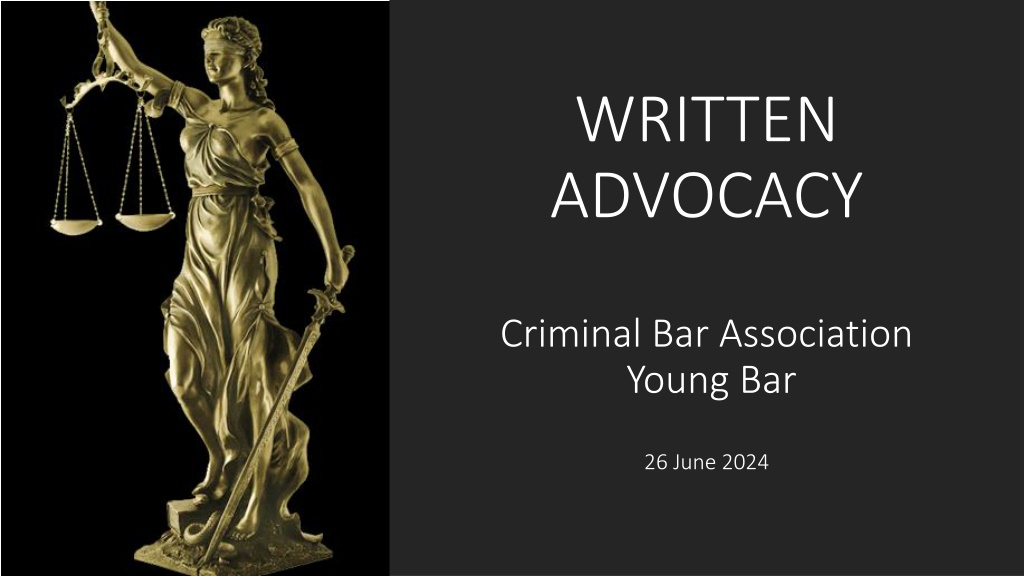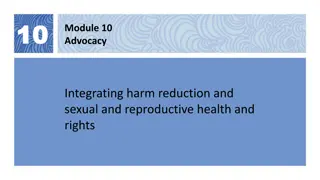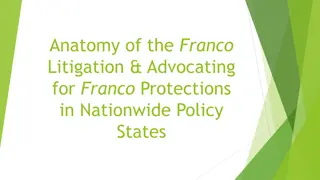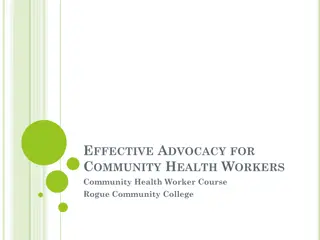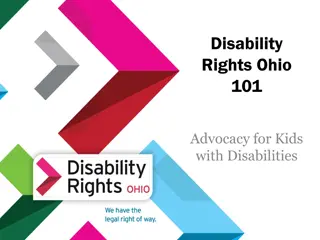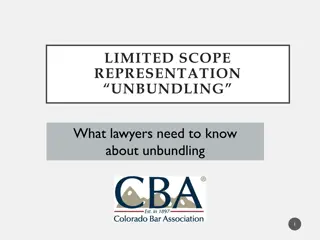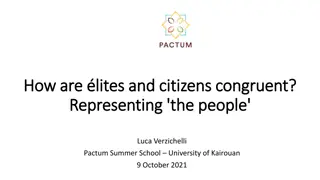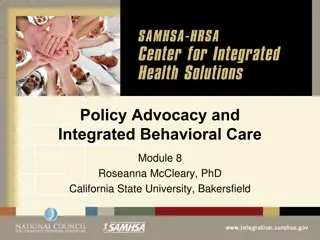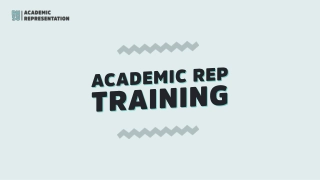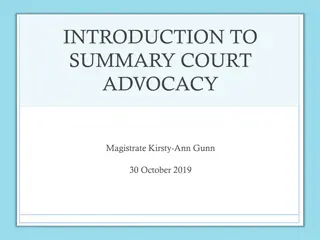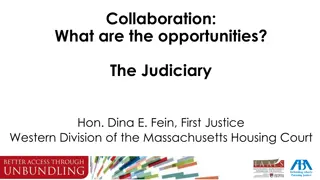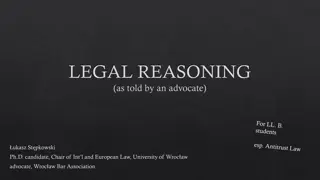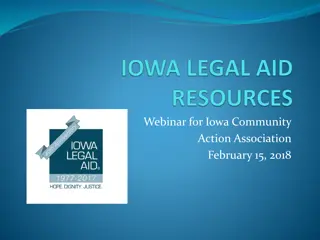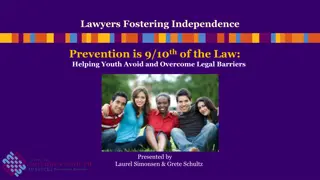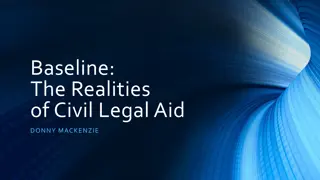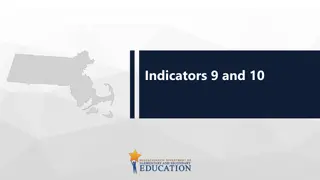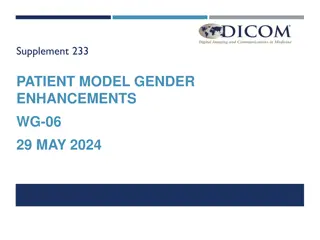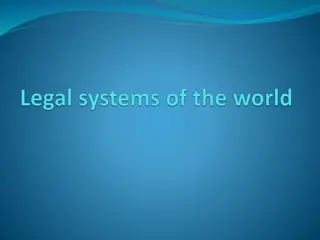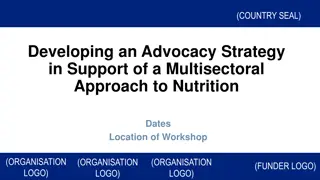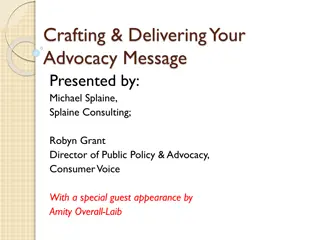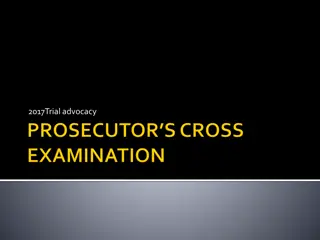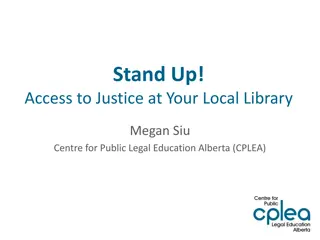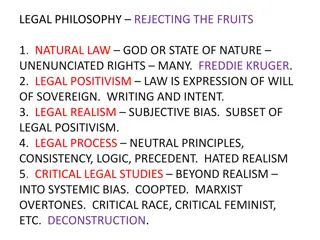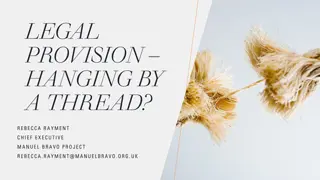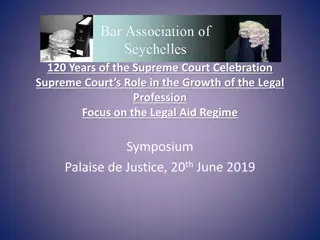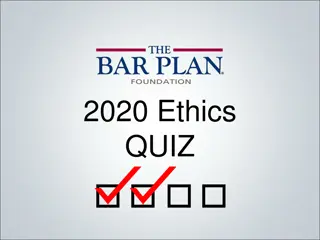Enhancing Written Advocacy Skills for Improved Legal Representation
Explore the critical aspects of written advocacy in legal proceedings, including the importance of preparation, case ownership, and effective communication with the judge. Learn how structured written submissions can influence case outcomes and elevate the standard of legal representation.
Download Presentation

Please find below an Image/Link to download the presentation.
The content on the website is provided AS IS for your information and personal use only. It may not be sold, licensed, or shared on other websites without obtaining consent from the author. Download presentation by click this link. If you encounter any issues during the download, it is possible that the publisher has removed the file from their server.
E N D
Presentation Transcript
WRITTEN ADVOCACY Criminal Bar Association Young Bar 26 June 2024
BACK TO BASICS SIR BRIAN LEVESON STYLE Review of Efficiency in Criminal Proceedings 2015 Remember it? How good written advocacy helps 1. Getting it right first time WA shows preparation & focus 2. Case ownership WA is influencing the judge for your side 3. Duty of direct engagement between the parties if it s in writing on the DCS there is no question it was done 4. Consistent robust judicial case management written submissions help the judge do this Bobbie Cheema-Grubb J 26 June 2024
Different to oral advocacy Different skill First impressions count It might be the last impression Tells the judge what his job is Ask: What does the judge need to know now, and what s the best way for my case to be presented to him? IT IS IT IS PERSUASION PERSUASION Bobbie Cheema-Grubb J 26 June 2024
Whenever it is going to help me. Pre-trial a note for a PTPH can save time and reading In trial in advance of a legal argument, time submission etc introducing the oral submissions In advance of any unexpected event in a case - to warm up the reception Whenever it is going to help you. Topics for summing up eg Lucas direction, sentencing note anywhere that there may be controversy or something complex In short: ask yourself What does the judge need to know now and what is the best way for my case to be presented to him? When do I want to see written advocacy? Bobbie Cheema-Grubb J 26 June 2024
STOP KEEPING ME INFORMED! said, no judge, ever. Bobbie Cheema-Grubb J 26 June 2024
How do KC Appointments define a high standard of written advocacy? Develops and advances client's case to secure the best outcome for client by gaining a rapid, incisive overview of complex material, identifying the best course of action, communicating the case persuasively, and rapidly assimilating the implications of new evidence and argument and responding appropriately. Bobbie Cheema-Grubb J 26 June 2024
Structure. Make it neat. Start with a clear, short, focused opening. Frame the issue with (i) a succinct description of what has to be decided (ii) deliver the answer to the question and (iii) the reasons for the answer The power of facts only cite what you need Lead with your own argument, not the other side s argument Quote from cases explaining the relevance. Perfect grammar, spelling, active/passive voice. The 6 most useful ingredients in a skeleton argument Bobbie Cheema-Grubb J 26 June 2024
What do I find most useful in a SA on bad character? A clear introduction telling me what is in issue. Enough about or of the evidence to explain its relevance/prejudice A route to admissibility through a s.101 CJA 2003 gateway/why it doesn t apply An argument for admission/exclusion Overall, a structure I can use easily in giving a rapid oral or written ruling. Bobbie Cheema-Grubb J 26 June 2024
Application - The defendant had a phone in prison with photographs of guns found on it. The bad character application (4 sides in total) began by giving notice and stating that the application was under s.101(1)(d) CJA 03. The application concerns compelling evidence of a continuing interest in guns whereas the defence case is that JB recoiled when the gun was handed to him after the shooting and did his best to get away from co-defendants thereafter. The next paragraph described the evidence in a narrative On 9 July 2021 at approx. 6.25 Prison Officers A, B and C were tasked with searching JB s cell at HMP X. JB was the sole occupant. As the officers entered, he was using a mobile phone KK/1. Extraction of the digital content was served on the defence on 29 January 2022. Then the prosecution summarised the content and explained the limited parts they wanted to introduce. The relevant part of the defence statement was quoted and in bullet points the matters in issue were listed. One case was quoted: In Lovell [2018] EWCA Crim 19, the value of the bad character evidence sought was not to show propensity but to rebut JB s professed reluctance to use a firearm similarly in this case is JB s asserted ignorance of and antipathy towards firearms and [YY the actual shooter.] Two paragraphs of argument describing how the jury could use this evidence safely and fairly. An Appendix of 10 pages of striking images from the phone showing the firearms. Bobbie Cheema-Grubb J 26 June 2024
The Defence Response Eight sides. Starting with a brief summary of what the prosecution applied to do. Defence submissions in bullet points A-F (one or two sentences for each.) Then each submission expanded in turn with extracts of images from the download included to demonstrate the context, the fact that other prisoners were using the phone at times (so they may have downloaded the images not him) and to demonstrate the lack of positive metadata-type evidence of how the images arrived on the phone. The defence explained how the prosecution understanding of the defence case was misconceived by quoting from the Defence Statement. Reference was made to two cases briefly pointing out that although relevant to the circumstances in the instant case the authorities suggested that evidence of past association with firearms might be admissible but did not consider evidence of subsequent association with firearms. This was a tenable argument for distinguishing the relative positions. Bobbie Cheema-Grubb J 26 June 2024
The Ruling I allowed the evidence in. My ruling was given immediately after the oral argument because I had been able to draft it in advance from the respective skeleton arguments and added to it as I heard the oral argument. My 14 paragraphs quoted from both the pros and def skeleton arguments in turn. The oral arguments fitted into the structure I had drafted because they were founded on the written submissions and both leading counsel sought to respond to what the other had put in writing. I was able to quote the defence arguments A-F (as expanded orally) and give my conclusions in turn. Bobbie Cheema-Grubb 26 June 2024
The Ruling My main conclusions were in three paragraphs, two of which read as follows: The images of guns found on the phone are striking. There are over a dozen. The phone was undoubtedly being used by the defendant in July to carry on conversations with friends. There is no evidence that anyone else used the phone in the week up to 7 July. If admitted the jury will be directed that if they are not sure the defendant was aware of the images then the evidence is irrelevant, and they must ignore it. If they are sure he was then the evidence is capable of shedding some light on whether he did join himself to an enterprise in which he knew there was to be shooting rather than an unarmed taking of a phone as his defence is. Against that the jury can fairly consider this evidence. The distance in time will have to be considered carefully by them. I also reject the argument, put in writing but not advanced in oral submissions that It cannot be permissible for the jury to use the later finding of images of firearms (if they could be safely attributed to JB) to inform themselves about the truth or otherwise of his assertion that he did not know that YY had a gun, or to inform themselves about his relevant actus reus / mens rea as a secondary party. Whether evidence to be admitted through this threshold pre or post-dates the relevant allegation is not determinative or a bar. Bobbie Cheema-Grubb 26 June 2024
Strive to always find the simplest expression you can clarity and logic win more arguments. George Orwell wrote 75 years ago that bad English corrupts thought and slovenly thought corrupts language. Think about that and don t add to it!! Basic tools never let you down different sentence lengths including at least one short sentence per paragraph, cutting out adjectives and any exaggeration/hyperbole because it makes your argument seem weaker. My favourite example: the prejudice to your client will never be transcendental or fatal . Be concise. That doesn t always mean being short. It means getting rid of unnecessary detail. Prune, prune and then prune some more. Give the judge what she needs to decide in your favour but no more. If the case isn t relevant desist from showing your knowledge she will not find it impressive. Have a dictionary and a Thesaurus to hand. Read widely to improve your use of English we can all get better. Two books to buy: Do I Make Myself Clear by Harold Evans, a former editor of The Times, and Point Taken by Ross Guberman who graduated from both Yale and the Sorbonne. Have a structure (use headings if it helps) and make the first sentence/paragraph count. Have the courage to rely on your best points rather than the kitchen sink and concede where you should. That gets you credibility. Finally, have humility TOP TIPS TOP TIPS Bobbie Cheema-Grubb J 26 June 2024
Justice Robert Jackson USA Solicitor General I make three arguments in every case. First comes the one I planned and wrote which was coherent, complete and logical. Then came the one that I actually presented in court; interrupted, incoherent, disjointed, disappointing. The third was the utterly devastating argument that I thought of after going to bed that night. You too, will live to fight another day . Bobbie Cheema-Grubb J 26 June 2024
Written advocacy DUNCAN ATKINSON KC
Stages of preparation 1. Research the facts 2. Identify the issues 3. Research the law 4. Formulate your argument 5. Identify the arguments against you 6. What does the Judge want 7. Start drafting
A practical example
Case details Name of defendant: CHRISTOPHER COLE THE DEFENDANT Court: CROWN COURT AT LEWES Case reference number: T20207310 The Bad Character Notice Charge: MURDER This notice is given by the prosecutor I want to introduce evidence of the bad character of CHRISTOPHER COLE on the following ground(s) in the Criminal Justice Act 2003: it is important explanatory evidence: s.101(1)(c). it is relevant to an important matter in issue between that defendant and the prosecution: s.101(1)(d). it has substantial probative value in relation to an important matter in issue between that defendant and a co-defendant: s.101(1)(e). it is evidence to correct a false impression given by that defendant: s.101(1)(f). that defendant has made an attack on another person s character: s.101(1)(g).
1. The Facts of the misconduct The court will want to know: 1. 2. 3. What is the misconduct you are relying on Where the evidence for that is give DCS references How you will prove it at trial Make it easy for the court they will not have time to do the research themselves. And reassure the court about satellite litigation.
1. The facts of misconduct The prosecution seeks to adduce evidence of the following matters: (1) The defendant was controlling of and would argue with the deceased; (2) The defendant had previously sought to obstruct the breathing of a partner as part of his controlling behaviour towards her and/or in the course of arguing with her; (3) The defendant had similarly obstructed the breathing of another female when he was upset, intoxicated and angry; (4) The defendant would sexually penetrate the deceased when she was asleep. The evidence for these allegations derives from witness statements that have been uploaded to the DCS from WITNESSES A-D Rebecca Sheppard [I131], Louise Nye [I134], Ellie Chilton [I139] and Kirsty Llewellyn. The last of these has not been included in the statements bundle thus far because it is recognised that her evidence depends for its admissibility on the resolution of this application, whereas aspects of the evidence from the other witnesses are submitted to be admissible whether this application is successful or not.
2. How to prove the misconduct The prosecution is in a position to call each of the witnesses above to give evidence of the matters summarised above. To the extent that Rebecca Sheppard WITNESS B in particular recounts things she was told by the deceased, it is submitted that these are admissible pursuant to section 116, Criminal Justice Act 2003. A notice under that provision will also be uploaded. It is recognised that the Court may consider that aspects of, in particular the statement of Ms Llewellyn WITNESS A beyond that summarised above may not need to be adduced the extent to which the evidence will need to be adduced will depend on the nature of the challenge to it, and the extent of its relevance in the light of that challenge.
3. Reasons why it is admissible In many cases, this will be the extent of the written advocacy to support the bad character application and so it needs to set out: Which gateway(s) are relied on Why they are relied on what issues the evidence goes to and - how those issues are addressed by the gateway(s) you rely on How the facts you have set out are relevant to to those issues and fit with that gateway
3. Reasons why it is admissible The prosecution submits that parts of this evidence do not fall within definition of reprehensible behaviour in the Criminal Justice Act 2003 ( CJA 2003 ) so as to represent bad character. For example, evidence that the defendant argued with the deceased, or for that matter WITNESS A Ms Llewellyn, or was controlling of his partner in either case. However, it is recognised that other aspects of the evidence identified above does fall within the CJA 2003. SET OUT SECTION SECTION 101(1)(d) AND SECTION 103, CJA 200 It is important to note that the prosecution does not have to satisfy the court that the defendant has a propensity in order to satisfy section 101(1)(d). The test for admissibility is whether the evidence is relevant to an important matter in issue between the defendant and the prosecution. This interpretation of the subsection was enunciated in McAllister [2009] 1 Cr. App. R.10. Moses L.J. observed (at paras.14 & 15): Asking a jury to look at evidence relating to a number of allegations as a whole in order to cast light on the evidence relating to an individual offence is not asking a jury to consider a propensity to commit an offence; on the contrary, it is merely asking the jury to recognize that the evidence in relation to a particular offence on an indictment may appear stronger and more compelling when all the evidence, including evidence relating to other offences is looked at as a whole. In other words, the evidence is adduced not as evidence of a propensity but rather to explain and augment other evidence of guilt.
3. Reasons why it is admissible Important matters in issue between the prosecution and defendant The defendant has pleaded not guilty to the murder of THE DECEASED Sarah Clayton. The question of whether the defendant was involved in the murder is an important matter in issue between the prosecution and defendant. The defendant is yet to file a defence case statement; however, in interview he denied any involvement in the death of THE DECEASED Sarah Clayton, and asserted that he loved her and would not hurt her. In support of an application to dismiss, he has served evidence from his parents who attest that the relationship between the defendant and deceased was a good one, and calls into question whether witnesses who describe hearing the defendant and deceased arguing on the night of Ms Clayton s THE DECEASED S death were accurate in attributing what they heard to the defendant. As part of the assessment of that question, issues are also raised between the parties as to the nature of the relationship between the defendant and deceased, and whether, as the prosecution contends, the death was caused by the obstruction by the defendant of Ms Clayton s THE DECEASED S breathing.
Reasons why it is admissible continued It is submitted that the jury, in considering the other evidence that shows the defendant was responsible for the killing through such obstruction of breathing, is entitled to consider whether it is likely to be coincidence that: (a) The defendant was controlling of and would argue with the deceased. This supports the accuracy of the evidence of those at the camp site on the night of the death as to the state of the relationship at that time, and undermines the contention of the defendant, supported by his parents, that he and the deceased were on good terms and that he would not hurt her; (b) The defendant could become aggressive when he became angry or upset, and when under the influence of alcohol. This is demonstrated both historically by WITNESS A Ms Llewellyn and in the context of his relationship with the deceased by his behaviour towards the deceased and towards Louise Nye WITNESS D. This evidence is relevant to the accuracy of the description of his behaviour on the night of the death, in that it is consistent with the description of his behaviour in the lead up to the sounds of items being struck against someone, and then the sounds of breathing difficulties; (c) The defendant had previously sought to obstruct the breathing of a partner as part of his controlling behaviour towards her and/or in the course of arguing with or feeling angry towards her, and had similarly obstructed the breathing of another female when he was upset and angry. This is of direct relevance to the question of how Ms Clayton THE DECEASED died and who caused her death. Evidence from eyewitnesses establishes that the defendant had become angry on the night of the death, before sounds that the jury would be entitled to conclude related to obstruction of breathing were heard. In short, the prosecution submit that the jury are entitled to consider that it is unlikely to be a coincidence that an explanation for Ms Clayton s THE DECEASED S death is that she was suffocated at a time when alone with the defendant, who had become angry with her, when it is known by them that he has previously resorted to actions that obstructed the breathing of another when he was similarly angry and/or intoxicated. It is a relevant factor for the jury to consider in determining whether the prosecution has proved the causation of the death, and the circumstances in which that death occurred.
The skeleton argument Decide if you are adding to the notice, or replacing the notice If adding to the notice, you need to refer back to it so it is clear how the 2 work together give DCS references If it is replacing the notice, make sure the skeleton includes the matters set out above: 1. The misconduct relied on 2. Where the evidence for that is, and how it will be proved 3. What the issues are, and how the evidence fits through a gateway.
Introduction The Crown rely on the bad character notice at page Q49, save that the Crown do not seek to call evidence that the defendant would sexually interfere with THE DECEASED Sarah Clayton or anyone else in their sleep. As such, the matters at page 2 point (4) of the notices, and the penultimate paragraph at page 5 of the notice, are not relied on. The matters which the Crown seek to adduce from WITNESS A Kirsty Llewellyn are set out in the annotated statement at page Q123 and 135. The matters in issue are: a. The true nature of the relationship between THE DECEASED Sarah Clayton and the defendant; b. Whether the death of THE DECEASED Sarah Clayton on the night of an argument with the defendant while sharing a tent with him was a coincidence. The fact that the defendant and THE DECEASED Sarah Clayton were argumentative, it is submitted, is relevant to the nature of the relationship but is not evidence reprehensible conduct. However, the evidence that the defendant was controlling and the evidence of violence is properly described as evidence of bad character.
The Law Set out the gateway (and refer to any other sections of the CJA 2003 relevant to the gateway) Then address the law as to the particular way in which you say that the issue in the case fits with that gateway Cite the relevant parts of the case (with paragraph numbers and/or references to Blackstones or Archbold) don t make the judge have to go off to do the research Help the judge to see why you have cited what you have cited
The Law Admissibility under section 101(1)(d) Section 101(1) of the Criminal JusticeAct 2003 so far as relevant provides: "In criminal proceedings evidence of the defendant's bad character is admissible if, but only if - ..... (d) it is relevant to an important matter in issue between the defendant and the prosecution. Section 101(1)(d) is then augmented by section 103, the principal parts of which for present purposes read as follows. "(1) For the purposes of section 101(1)(d) the matters in issue between the defendant and the prosecution include --(a) the question whether the defendant has a propensity to commit offences of the kind with which he is charged, except where his having such a propensity makes it no more likely that he is guilty of the offence;
The issue and the law relating to it Coincidence as a matter in issue It is well established that matters in issue are not limited to propensity commit offences of the kind charged and propensity to be untruthful. A matter in issue includes whether events occurred by chance/coincidence, or whether they were linked. We have uploaded three authorities, the relevant parts of which are summarised below. In R v Jordan [2009] EWCA Crim 953, a case in which the defendant was found in the passenger seat of a car with a firearm hidden under the seat, Hallett LJ DBE stated (at paragraph 20) that: Section 103(1) states that matters in issue between the Defendant and the prosecution for the purposes of s 101 include the question whether the Defendant has a propensity. Matters in issue are not limited to questions of propensity. One important matter in issue here was whether or not the Appellant knew there was a firearm in the car. It was to rebut his claim that he just happened to find himself sitting above the firearm, in other words to rebut his claim of innocent association or coincidence, that the Crown in reality sought to adduce evidence of his previous convictions. The admissibility of evidence to rebut coincidence or innocent association was recognised by this court in Groves [1998] Crim LR 200, but also more recently in R v Chopra [2006] EWCA Crim 2133, [2007] 1 Cr App Rep 16, whereby this court acknowledged that coincidence or unlikelihood of coincidence continued to be relevant under the provisions of the Criminal Justice Act 2003. [emphasis added]
Set out the other relevant authorities and then add the conclusion on the issue It is submitted that, in the context of the case against THE DEFENDANT Mr Cole, the character of the defendant is a relevant consideration for the jury. The jury would be entitled to consider the character of the defendant when assessing the competing propositions that either (a) THE DECEASED Ms Clayton died of an undetectable and unforshadowed natural occurrence which struck, wholly by chance, on the very night that she was not only sharing a tent with the defendant, but had also been violently arguing with him, or (b) that THE DECEASED Ms Clayton had been smothered by the defendant.
Address the concern about satellite litigation The scope of litigation required It is important in this case, as in any case, for the trial to remain focused on the essential issues. This does not mean that only unchallenged evidence of bad character can be admitted. Whenever challenged evidence of bad character is to be admitted, there will need to be some litigation of the issues which the jury will have to resolve. The Crown have narrowed the matters which are sought to be adduced, as per the edited statements. These are matters which can be properly challenged by the defendant by cross examination of the relevant witnesses. In the context of a murder trial, where the sole real issue for the jury is whether THE DECEASED Ms Clayton died at the hands of the defendant or by chance, it is submitted that the character evidence is both sufficiently important, and sufficiently focused, that this additional litigation would not lead to unfair distraction. The evidence has been timetabled for a day, in the context of a murder trial with an overall time estimate of three weeks.
5 top tips for written advocacy
5 top tips Be clear what you want to achieve Make that clear to the Judge Make the task easy for the Judge Give the Judge the law they need (and no more than they need!) Anchor your argument to the law and the issues
